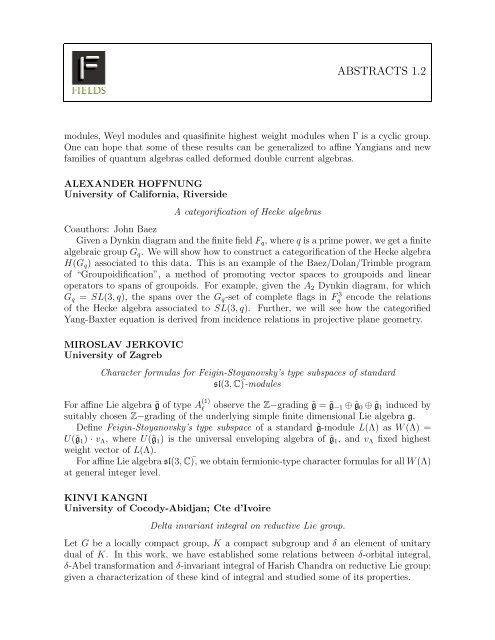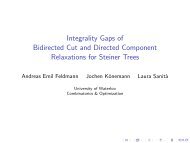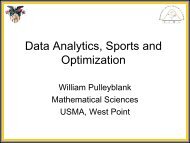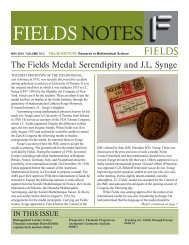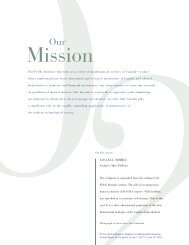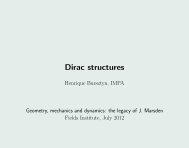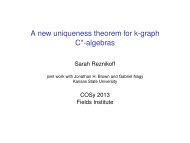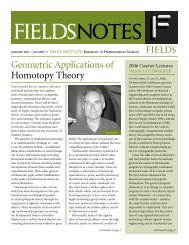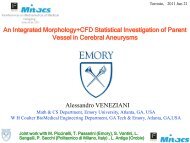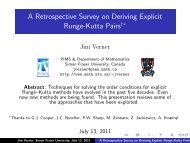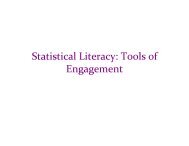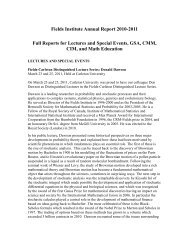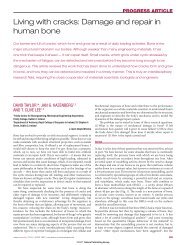ABSTRACTS 1.2 Invited Talks - Fields Institute - University of Toronto
ABSTRACTS 1.2 Invited Talks - Fields Institute - University of Toronto
ABSTRACTS 1.2 Invited Talks - Fields Institute - University of Toronto
You also want an ePaper? Increase the reach of your titles
YUMPU automatically turns print PDFs into web optimized ePapers that Google loves.
<strong>ABSTRACTS</strong> <strong>1.2</strong><br />
modules, Weyl modules and quasifinite highest weight modules when Γ is a cyclic group.<br />
One can hope that some <strong>of</strong> these results can be generalized to affine Yangians and new<br />
families <strong>of</strong> quantum algebras called deformed double current algebras.<br />
ALEXANDER HOFFNUNG<br />
<strong>University</strong> <strong>of</strong> California, Riverside<br />
A categorification <strong>of</strong> Hecke algebras<br />
Coauthors: John Baez<br />
Given a Dynkin diagram and the finite field Fq, where q is a prime power, we get a finite<br />
algebraic group Gq. We will show how to construct a categorification <strong>of</strong> the Hecke algebra<br />
H(Gq) associated to this data. This is an example <strong>of</strong> the Baez/Dolan/Trimble program<br />
<strong>of</strong> “Groupoidification”, a method <strong>of</strong> promoting vector spaces to groupoids and linear<br />
operators to spans <strong>of</strong> groupoids. For example, given the A2 Dynkin diagram, for which<br />
Gq = SL(3, q), the spans over the Gq-set <strong>of</strong> complete flags in F 3 q encode the relations<br />
<strong>of</strong> the Hecke algebra associated to SL(3, q). Further, we will see how the categorified<br />
Yang-Baxter equation is derived from incidence relations in projective plane geometry.<br />
MIROSLAV JERKOVIC<br />
<strong>University</strong> <strong>of</strong> Zagreb<br />
Character formulas for Feigin-Stoyanovsky’s type subspaces <strong>of</strong> standard<br />
sl(3, C) e -modules<br />
For affine Lie algebra ˜g <strong>of</strong> type A (1)<br />
ℓ observe the Z−grading ˜g = ˜g−1 ⊕ ˜g0 ⊕ ˜g1 induced by<br />
suitably chosen Z−grading <strong>of</strong> the underlying simple finite dimensional Lie algebra g.<br />
Define Feigin-Stoyanovsky’s type subspace <strong>of</strong> a standard ˜g-module L(Λ) as W(Λ) =<br />
U(˜g1) · vΛ, where U(˜g1) is the universal enveloping algebra <strong>of</strong> ˜g1, and vΛ fixed highest<br />
weight vector <strong>of</strong> L(Λ).<br />
For affine Lie algebra sl(3, C) e , we obtain fermionic-type character formulas for all W(Λ)<br />
at general integer level.<br />
KINVI KANGNI<br />
<strong>University</strong> <strong>of</strong> Cocody-Abidjan; Cte d’Ivoire<br />
Delta invariant integral on reductive Lie group.<br />
Let G be a locally compact group, K a compact subgroup and δ an element <strong>of</strong> unitary<br />
dual <strong>of</strong> K. In this work, we have established some relations between δ-orbital integral,<br />
δ-Abel transformation and δ-invariant integral <strong>of</strong> Harish Chandra on reductive Lie group;<br />
given a characterization <strong>of</strong> these kind <strong>of</strong> integral and studied some <strong>of</strong> its properties.


